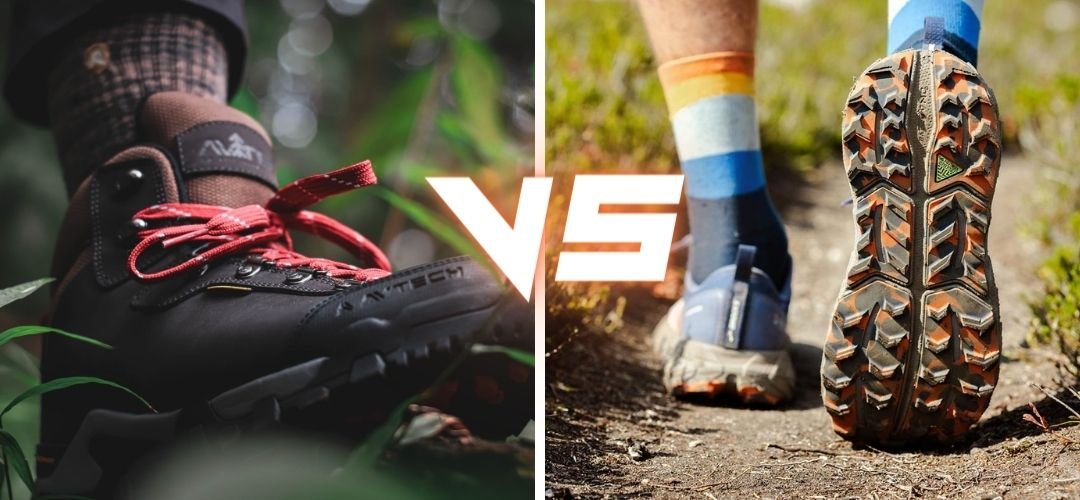Hiking Boots vs Trail Runners – What Should You Choose? What are the best walking shoes? Trail runners are the biggest new trend with long-distance walkers. When it comes to thru-hikes, they’ve essentially replaced hiking boots.
Even so, it’s common for people to be nervous about trying them. After all, hiking boots have been the mainstay of backpacking for years. How can these seemingly lightweight trainers possibly match up?
Hiking Boots vs Trail Runners — What’s the difference?

Visually, there’s a massive difference between the two.
Hiking boots are high cut, rugged-looking and tend to be neutral in colour. Think browns, greys and blacks. They usually feature standard lacing systems and conjure images of backcountry hiking across challenging terrain.
Trail runners, on the other hand, look more like sporty trainers. They’re low cut, available in obnoxiously bright colours and often have futuristic quick lace systems. Normal laces are available too.
The differences don’t end with the aesthetics though.

Weight
Hiking boots are 40-60% heavier than trail runners. This is because they have more mass. Their higher cut means more material is required in the construction and the soles tend to be much chunkier.
It’s also more common to find heavy materials such as leather or suede in hiking boots. Synthetic models are available but animal hide is still very popular.
Trail runners just use less material and what they do use tends to be super lightweight. Synthetic mesh and breathable fabrics are most common. They also feature foam style midsoles which help keep the weight way down too.
Having lighter shoes keeps your legs and feet feeling fresh for longer while on the trail!
Comfort
Both trail runners and hiking boots are available with a ton of cushioning along the sole. However, boots also feature cushioning around the rest of your foot and ankle.
Trail runners are low cut, opting for low weight and breathability over cushioning. They’re more minimalist and give plenty of room for your feet to move and shift as you walk. They’re also more flexible which allows your feet to work through their natural range of movement more effectively.
Some hikers find boots too constricting. Others appreciate the extra support and cushioning offered.
It’s worth noting that you need to break hiking boots in before wearing them on trail. The stiffer construction and firmer materials can cause severe rubbing and blisters if you’re not careful.
RECOMMENDED READ: Backpack vs Suitcase – Which one Should You Use?
Support
Both trail runners and boots are available with varying levels of arch support. With boots, it doesn’t stop there. Their high cut design delivers much more ankle support than the low cut trail runners.
While trail runners suit well-groomed trails and smooth terrain, the added support from boots helps keep you injury-free in more challenging environments. For steep mountain trails, rocky paths or deep forests, boots are often the better choice.
Protection
By looking at hiking boots and trail runners side by side, it’s easy to see which provides more protection.
The thicker material, rugged soles and high cut of hiking boots mean more of your feet are covered. Whether it’s protecting from the elements, sharp objects or the tough ground, boots will always offer more protection.
Some trail runners also feature thick soles which keep your feet safe from below. They don’t have ankle protection but allow your feet to move more naturally. This reduces the risk of injury by allowing you to build muscle and retain the natural flexibility in your feet.

Waterproofness
Both trail runners and hiking boots are available in waterproof and non-waterproof models.
But honestly, waterproof trail runners are a waste of time. The low cut nature of trail runners means if you’re hiking in a wet environment, water will almost always get in. It’s better to accept this and opt for non-waterproof versions which dry out much faster.
RECOMMENDED READ: Full-Time Wanderlust: Top Jobs That Allow You to Travel and Work Remotely
On the other hand, when it comes to hiking boots, good waterproof materials do work. They can keep you dry for days of rain and puddles. Beware, if water does get inside waterproof boots, they can take an age to dry out.
It’s also worth noting that if you’re hiking in spring, summer or autumn, fully waterproof boots might be overkill. They don’t breathe as well and can cause your feet to overheat.
Durability
Hiking boots are almost always more durable than trail runners. A good pair of boots should last at least 1000 trail miles while decent trail runners will need replacing every 300-500 miles.
Cost
Hiking boots are more expensive than trail runners. Sometimes the price difference can be hundreds of dollars between high-end models!

Final Thoughts On Trail Runners vs Hiking Boots
At the end of the day, it all comes down to personal preference and what you find most comfortable. There’s pros and cons to everything and footwear is no exception. The terrain, conditions and level of support you need will all play an important role in choosing between trail runners and hiking boots.
Trail runners are favoured by long-distance hikers for their weight, flexibility and how quickly they dry. Heavy boots can easily tire out the wearer while trail runners allow you to skip along simple terrain with ease.
Hiking boots come into their own when the terrain gets more difficult. Extreme rocky trails and steep elevation changes can play havoc with your feet and ankles. Boots offer more support and help protect the wearer from injury.





Thank you folks for that detailed breakdown of pros and cons. I am sure this will help potential hikers to choose between the two.
Thank you so much!
Thank you so much!
You are welcome!